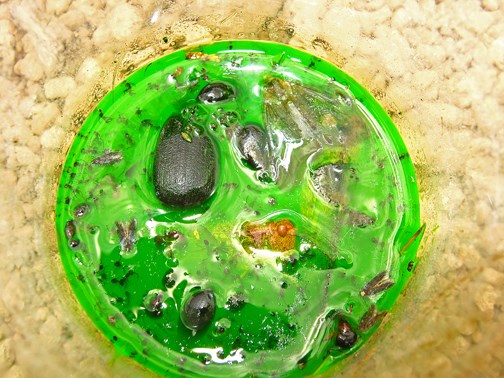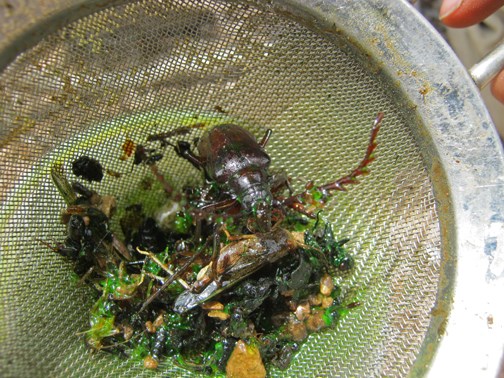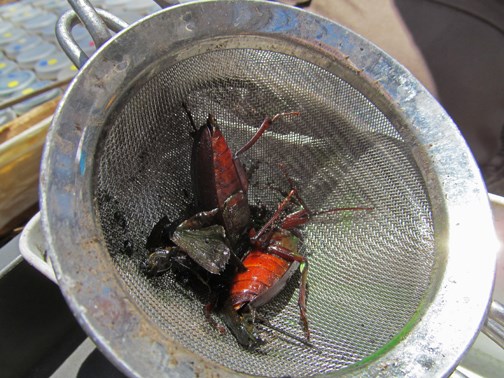
NPS IMAGE
To collect samples from the pitfall traps my partner, Courtney, and I went out to each collection site armed with anti-freeze, ethanol, and a toolbox full of cups, cans, strainers, funnels, and chopsticks. Each 'pitfall' is a cup filled partially with bright green anti-freeze and stored securely in a soup can that is level to the ground. Anti-freeze is used in order to prevent evaporation and preserve the samples. We use a less-toxic version with a bittering agent to prevent animals from drinking it.
The traps are camouflaged using a rock or piece of wood to prevent insects from being tipped off by light reflecting off the anti-freeze. This can make the traps hard to find but a GPS and bright-colored flagging generally help us find the traps. Plus when carefully inspecting an area, 'floating' rocks, which are a sure sign of a pitfall trap, tend to stand out.

NPS IMAGE
At each trap we strain out all the bugs in the cup. After collecting all our samples, a funnel and chopsticks help us fit our samples into glass vials to be sent to the University of New Mexico for identification. It is easier to place the larger insects in head first, not only because they fit better, but because many insects will stare at you with large eyes if you try to place them in the other way.
The beauty of the data collected comes from the large variety of species that have been tracked over the years. Data collected has revealed how individual species respond to environmental changes- including weather and fire. All new species collected are added to Bandelier's growing arthropod collection, housed at UNM's Natural History Museum, giving the project value in helping to build a catalog of what species can be found within the park. In fact, some previously undescribed species such as a new minute brown scavenger beetle in the family Lathridiidae and a new darkling beetle in the genus Steriphanus have been discovered from the pitfall traps at Bandelier. In addition our pitfall traps are designed using the same protocol as several pitfall sites located across the state of New Mexico allowing for invaluable comparison of diversity and species response over a broad-scale.

NPS IMAGE
At Bandelier changes due to the El Niño Southern Oscillation weather pattern have been a particular focus of this project. El Niño has a strong impact on southwestern U.S. weather and its impact on arthropod diversity is continuing to be an interesting aspect of this long term study. This study has been able to gather data on diversity during normal years and assess changes in diversity due to La Niña (dry) years and El Niño (wet) years. In addition the elevation differences among the sites make it possible to study what effects higher elevation may have on diversity, due to its cooler temperatures, higher levels of precipitation, and differing vegetation types. In connecting these two factors it has been possible to see at which elevations populations are most susceptible to changes from droughts and shifting climate patterns.
Hiking down the switchbacks with our last set of arthropod samples in hand, I thought of how diverse the insect world is. Over the course of 102 traps we had seen an amazing variety of insects from tiny black ants to brown beetles that were too big for the funnel and almost too big for a vial. We collected an assortment of crickets, spiders, beetles and even velvet ants, which despite their name, are actually flightless wasps. It's fascinating to see what turns up in each trap, especially because many of the insects in our traps are so elusive in lifestyle and habitat as to rarely be seen by hikers. It was a great experience to be part of such a unique long term study on arthropod diversity.
